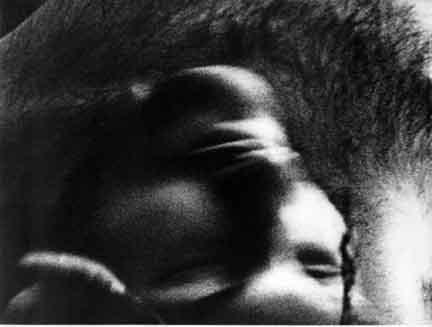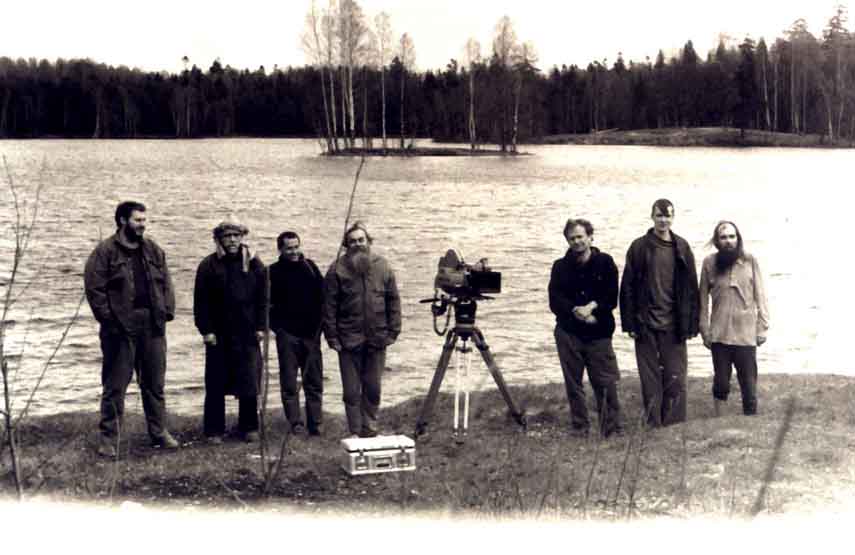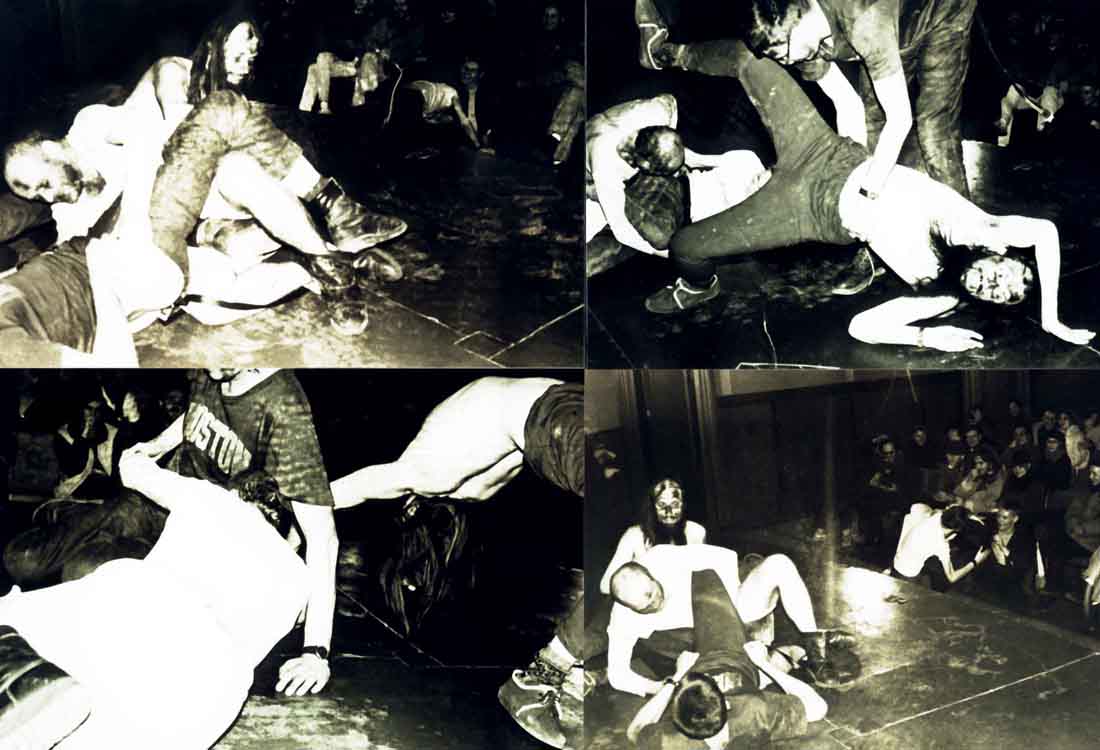Yevgeniy Yufit
regisør fra St. Peresburg
_____________________
Yevgeniy Yufit was born in 1961 in Saint Petersburg, Russia.
In the early 1980s he began working as a painter and art photographer.
In 1985 he set up the first independent film studio in Russia,
MZHALALA FILM, which brought together artists, writers, directors
and others sympathetic to radical aesthetic experimentation.
At this studio Yufit made a number of films which have been shown
at the world's major film festivals including Montreal, Locarno,
Toronto, Rotterdam, and Moscow. His film Papa, Father Frost
Is Dead was awarded the Grand Prix at the Rimini Film Festival
in Italy. Yufit's paintings and photographs have been shown in
major exhibitions of contemporary Russian art since 1985, at
the State Russian Museum, Saint Petersburg; Stedelijk Museum,
Amsterdam; Kunsthalle, Dusseldorf; Kunstverein, Hannover and
The Museum of Modern Art, Mexico City. Works by Yufit are to
be found in museums, galleries and private collections both in
Russia and abroad.
SELECTED PERMANENT COLLECTIONS
The Museum of Modern Art (New York)
The State Russian Museum (Saint Petersburg)
The Netherlands Film Museum (Amsterdam)
SELECTED EXHIBITIONS AND FILM SCREENINGS
Screening of The Wooden Room
Film Society of The Lincoln Centre (New York, USA)
Films of the Glasnost Era
1996 Harvard Film Archive (Harvard University, USA)
Screening of The Wooden Room
1997 Stedelijk Museum (Amsterdam, The Netherlands)
Exhibition of contemporary Saint Petersburg artists
The Museum of Modern Art (New York, USA)
Screening of Papa, Father Frost Is Dead and The Wooden Room
The State Russian Museum (Saint Petersburg)
The Films and Photographs of Yevgeniy Yufit
1998 "Last House on the Left", Archipelago, Stockholm (Sweden)
1999 28th International Film Festival (Rotterdam, The Netherlands)
The Museum of Modern Art (New York, USA)
Screening of Silver Heads

FILMOGRAPHY
1984 Werewolf Orderlies 1989 Warriors of Heaven
1985 Woodcutter 1991 Papa, Father Frost is Dead
1987 Spring 1994 Will
1988 Fortitude 1995 The Wooden Room
1988 Suicide Monsters 1998 Silver Heads

"Early necrorealist declarations affirmed the life of the body abandoned by the soul and advocated pure idiocy, uncorrupted by instinct or the subconscious. Their short films recall Mack Sennett's slapstick style of the 1910's and the shock aesthetics of the French avant-garde, as well as the unrestrained eccentricity of the Soviet cinema of the 20's. Characters thickly plastered with zombie clay enact mass brawls, suicides, and monosexual erotic acts. In such strategies it was easy to discern provocations towards the Soviet myth of social immortality". (Sergei Dobrotvorsky: "A Tired Death")
With a sense of black humor and the absurd, which was not at all characteristic of Soviet consciousness , early "Necrofilms" expressed fascination with various forms of decay and death, from the miasmic language of official ideology to the expiration of the individual body.
The strange title of the controversial and cynical art-group had a number of resonances. The prefix "necro" was both a reminder of taboos and the transgression of these taboos. The taboo on communism's death in the Soviet period of perestroika was the primary object of such cynicism.
At the same time, Necrorealism, meaning "death realism", corresponds to the official Soviet aesthetics of "socialist realism". Indeed, the ideology of the Soviet establishment, its collective ethics and heroic pathos, were the main objects of early necrorealistic violation and parody. Well-known figures in the uniforms of socrealism - soldiers, sailors, doctors, secret service agents, and the like - often appear in early necrorealistic slapstick films such as Yufit's SPRING and SUICIDE MONSTERS. Mass murders and suicides by these familiar types are shown as motivated by paranoia, a natural consequence of Soviet collectivist ethics. In necrorealistic treatment, the characters are seen as living dead or as zombies completely caught up in parodic scenarios of "heroic idiocy".
Early "Necrofilms" do not present a positive critique; they do not seek to revitalize an outmoded
cultural order. Instead, the pure absurdity of the living dead, the zero degree of being and meaning, represented in these films, exposes the suppressed underground history of the Soviet era, depicting the bankruptcy and exhaustion of its myth of social renewal and revealing the hollowness and banality of the images that continued to reflect that ideology. Shot in 16mm under deliberately rudimentary conditions, these films develop an aesthetic intended to record the transformations of the body in the throes of death.
Necrorealist art situates itself on a conceptual boundary between life and death. Here death is the metaphor for such manifestations of human consciousness as mental dullness, spiritual decay, and emotional emptiness.
In 1989, Necrorealism began to attempt to downplay its underground reputation so as to be able to gain financial support through the Leningrad State Film Studio. Alexander Sokurov organized a film school at Lenfilm Studio, which included necrorealist filmmakers. The group of Necrorealists was given the official approval to make 35mm films. Many sought the new art-status, but only Yevgeniy Yufit graduated from the school and was able to make feature films. Several members of the necro-group became actors in Yufit's films, while several others changed their media and aesthetic direction. Since that time, Yuft has shot three full length films : "Papa, Father Frost Is Dead", "The Wooden Room", and "Silver Heads".
The connection to the State Cinema did not, however, alter the essential peculiarity of Necrorealism. Necrofilms remain in every sense alternative films, for they repudiate the establishment's injunction to be conventional. At the same time, Necrocinema has switched from 16mm to 35mm format and has moved toward a more documentary approach to "reality". New camera techniques, deep focusing and shots-in-depth, have reduced the need to break up scenes into a series of shots and have rehabilitated the physical reality of death after it ceased to be a demarcated zone of the Soviet cultural landscape.
Nature, another primary focus of the necro-statement, began to attract the attention of the camera. Nature, in the self-reflexive world of Yufit's characters (necrotypes), reflects a clear evidence of the death of evolution. For example, the "flock of grandfathers" in the film "Papa, Father Frost is Dead", their benumbed surroundings and the implication of their homosexuality, embodies an idea of unresolved mystery, a type of natural irrationality that challenges the repressive law of reproduction of the human species. Notions of sexuality at times are altogether nullified in the scenes where homosexual acts are expressed as pure violence rather than sensuality.
Nature is also depicted in such a way that, via its omnipotent force, it obliterates the anomaly of consciousness, erasing its natural and cultural gradations, substituting planks of wood, stones, hedgehogs and sticks for anthropological specimens.
Yufit's cinematography seems to be evolving towards perceiving nature through the gaze of a naturalist.
As a direct result of this naturalistic approach, montage has gradually disappeared from necrofilms. The early pictures were built on the principle of short static scenes, proceeding headlong one after another. Over time, the tempo of the films slowed down, and the scenes were more and more often shot in one general take. As Pier Paolo Pasolini once said, "Montage acts on film material as death acts on life there is no purpose in breaking up action into conceptual segments." The new slow, drawn out "Necrofilms" seem to illustrate Andre Bazin's theory of the ontological nature of film. Here the physical and metaphysical coexist in one cyclical space. Life and death do not appear as opposites when man and corpse enjoy the same right to wander through a vacuum of senseless emptiness. One could describe necroart as the specifically Russian manifestation of Jean Beaudrillard's concept of "the total implosion of meaning."
The cinematography of Necrorealism has turned away from the rough-edged montages of the carnivalesque death of the Soviet ethics and has absorbed itself completely in the timeless rhythms of life. Motionless black and white shots, suggestive of Yufit's still photographs, emphasize the goal of aestheticizing the elements of nature. In place of characters or protagonists rises up an anomalous Nature incapable of nurturing humans.
Aside from the agonizing portrayals of death, Necrofilms reflect the beauty of the timeless vacuum they contain. As a Russian theorist Victor Mazin writes, "Necrorealism develops the existentialist ideas of [a Russian philosopher] Nikolai Fedorov, who devoted his life to the dead, for human beings cannot forget about mortality, that's all they think about."
It seems that necrorealism is reviving the eccentrism that was persistently purged during the nurturing of the post-revolutionary soviet world, a world in which there was no spiritual center, no up and down, no meaning and no passion, neither being nor nonbeing. Now, however , with the time of 'nonexistence' and post-apocalyptic world views having passed, Necrorealism seeks to portray more pure types of biological and mental eccentrism.
It holds the view that, in spite of all social cataclysms, human beings have not changed. In short, Homo Sapien is a more aggressive, disharmonious and mentally destructive species than any other.

En nekrorealistisk happening
Oppdatert 21.03.00